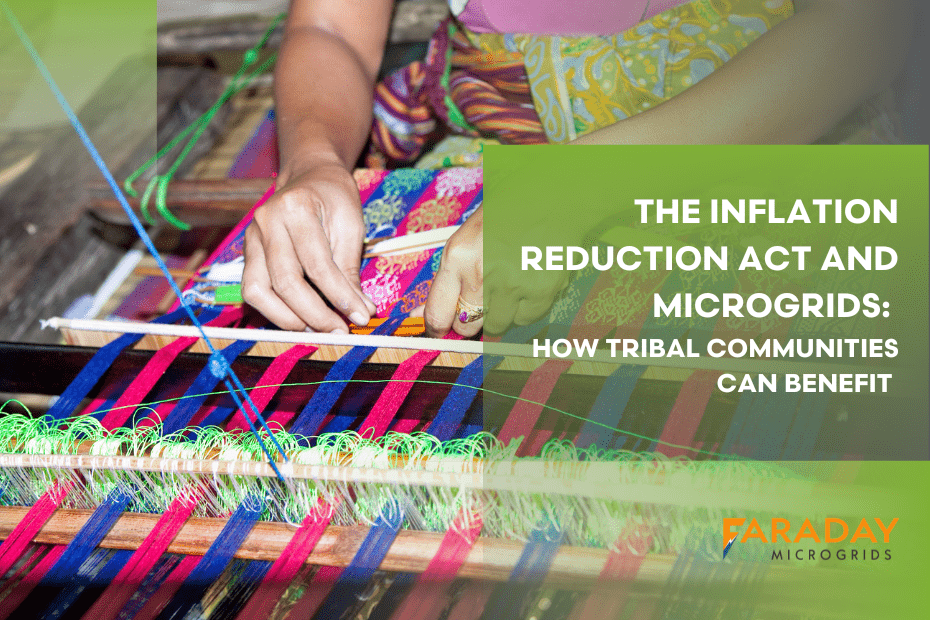According to the whitehouse.gov, the Inflation Reduction Act provides additional investments for the Tribal Energy Loan Guarantee Program, and increases loan guarantees for Tribal energy development from $2 billion to $20 billion.
Here are three ways tribal communities can benefit from the IRA’s sustainable energy provisions.
1. Tribes have the ability to profit from sustainable Microgrids
According to Quarles.com, the IRA provides three major types of funding for tribes, tribal enterprises, and tribal members:
- Tribal Specific Programs | New and increased grant and loan guarantee programs are available to implement energy projects for electrification, climate resiliency and energy generation.
- Tax Credits and Rebates | Direct payments from the IRS are available to tribes and tribal members that implement clean energy projects (solar, wind, geothermal, battery energy storage), electric vehicles and charging stations, and energy efficiency projects. This option is ONLY available to Tribes and Non-Profits.
- Environmental and Energy Programs | Expanded and new funding programs support Tribal efforts to achieve greenhouse gas emission reductions, environmental and climate justice, and rural renewable energy projects.
These new programs will have important impacts upon Tribal autonomy and sovereignty.
2. Microgrids increase tribe independence and sustainability
Tribes who adopt renewable energy microgrids may become virtually independent of the main grid. Indeed, many are leveraging microgrids to work towards becoming their own utilities and to no longer depend upon non-Tribal entities for power. This supports some of the most important values expressed by Tribal nations – independence, autonomy, self-determination, environmental and economic justice, and control of Tribal land – particularly in regions where the utility power supply is less reliable, too expensive, or unable to keep up with Tribal needs.
In many remote tribes, the loss of power can take up to ten days to restore. Tribal communities living at great distances from one another or conventional energy sources can be dramatically impacted by the loss of access to heating, cooling, internet, gaming and other commercial activities, and essential services.
Unlike utility grids, which go offline in the event of severe weather or other disruptive catalysts, microgrids have the unique ability to ‘island’, or independently retain and emit energy—even when the power is out. Doing so using renewable energy resources such as solar, wind, geothermal, and others support the desire of Tribal communities to utilize abundant, non-destructive energy resources and preserve the quality of the land, water, air, and wildlife for 7 generations or more.
Renewable energy drives down energy costs
The U.S. Energy Information Administration (EIA) reports that electricity prices have increased 1.8% per year in the United States for the past 25 years, from a national average price of 8.38 cents per kilowatt-hour (kWh) in 1994 to 13.01 cents/kWh in 2019 (the most recent year for which annual data is available). If you go all the way back to 1960, the average annual rate increases to around 2.8%. These price increases are particularly challenging for at-risk communities including the very young, the elderly, those with significant or long-term health conditions, and those who don’t have access to critical services.
Renewable energy microgrids address many of these problems. Through the use of renewable energy generation on-site, the systems slash the need for purchases of utility power. Indeed, some Tribes have turned this into a money-maker – selling power to the utilities instead. In addition, when the embedded intelligence in the microgrid optimizes the storage and deployment of on-site generation, it can provide for critical emergency power and significantly reduce peak demand fees charged by the utilities.
While the exact amount of savings or revenue will vary by Tribe, utility, and microgrid size, it is reasonable to say that overall cost reduction can be dramatic. In fact, with a large enough system, a Tribe could virtually eliminate utility costs and even become their own utility.
Want to find out more? Faraday Microgrids is committed to supporting and advocating for tribal communities.
Start a discussion today and learn more about microgrid installation:


